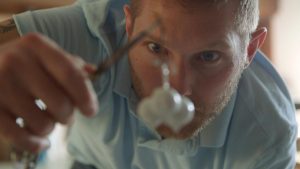Jesse Krimes: Krimes and Punishment
Description
Jesse Krimes describes his six years in federal prison as a kind of “artist residency.” Not only did his work keep him sane while on the inside, it’s become the foundation for a successful artistic career on the outside.
Featured Artists

Jesse Krimes is a well-regarded visual artist whose work highlights mass incarceration and crime.
Born in 1982 in Lancaster, Pennsylvania, Krimes graduated from Millersville University. Soon after earning his BA in art, he was imprisoned for five years on drug charges. With limited access to art supplies, he used hair gel, newspaper, bed sheets, plastic spoons, soap bars, and other material to create art drawn from and focusing on the prison experience. Following his release, his work exhibited at MoMA PS1, Palais de Tokyo, Philadelphia Museum of Art, the International Red Cross Museum, and other galleries and museums around the world.
He is the co-founder of Right of Return USA, a program to support previously incarcerated artists.
Transcript
Jesse Krimes says the time he spent in Federal Prison for drug offenses generated both desire and fear, enlightenment and profound disquiet.
Jesse Krimes: That time was one of the worst times of my life, but also one of the best.
The best of times because it was six years during which making art kept him sane.
Krimes: I call it a very long, bad residency.
Krimes, yes, that’s his real name, was just a year out of art school when he found himself forced to take stock of his own identity from behind bars.
Krimes: They can take your clothes, your car, they can remove you from your family, but they can’t take away your ability to create. That was one thing that I really understood as who I am as an individual, and one thing that no matter what situation I was placed in that I had this thing that would always kind of maintain my sanity and also give me a method of resistance to the idea of being a criminal.
AJC: Looking at the work that you did before you went in, and the work that you’re doing now, it’s not as different as it might have been.
Krimes: I think I was dealing with a lot of the same kind of aesthetic concerns and a lot of the similar issues that I was working through in my work previous to going to prison… Is much the same as the work that I’m continuing to do now.
AJC: So therefore is it annoying to you that you continue, as I’ve just done, to be defined by the fact that you are the dude who spent six years inside?
Krimes: I think it is kind of limiting in a sense, but I kind of knew that making artwork in the prison system was… Not a typical art process. So I had an idea that making these massive, monumental bodies of work within this environment was something that would potentially be interesting to viewers, and value.
But for however valuable his art ended up being, nobody was handing out easels and oil paints in Federal Prison. So, Krimes improvised with what was available. He used hair gel, newspaper, bed sheets, plastic spoons and colored pencils to create what would become a 39 panel landscape named in part for his prison ID number. It would eventually be smuggled out piece by piece. Another project, Purgatory, was comprised of 300 carved prison issued soaps, concealed inside decks of playing cards. As it happens, working with non-traditional media had always been his preference.
Krimes: A lot of my work happens through an intuitive way of… Almost by chance, of coming across materials.
And sometimes finding a starting point can be as simple as accidentally dropping your grape into a vat of primer.
Krimes: I pulled it out and, just the transformation of this grape, this kind of full, lush grape, this everyday thing that we encounter was really beautiful in this kind of white-coated state. So, I put it in tweezers and I wanted to see how it kind of changed over time. But then I found that the form of the tweezers holding the grape and the drip that solidified very interesting. I began to recognize that form in other elements that I came across in my daily life. So, I found this massive hornet’s nest dangling from a tree and it was like this whole kind of ecosystem that mimicked the same formal qualities of the grape. So, I put it in tweezers and developed this other extension that kind of holds the tweezers to dangle the hornet’s nest from this artificial structure. The project just kind of grew like that through all these different elements.
Since his release in 2013, Jesse Krimes has continued to grow professionally and personally. Though he lost most of his twenties to incarceration, he says he gained an understanding of the deeply nuanced nature of human relationships, that goes beyond today’s world of clicks, likes, and shares.
Krimes: This is the Federal system, so this is a community of individuals from every corner of the world. So in a way even though I didn’t leave this very small compound, I traveled the world and interacted with all of these vast different cultures and things that people bring in to this environment. I mean, so many people now form relationships and these groups of people who are like-minded, so you never get opinions from people who are outside of your comfort—
AJC: You live in the echo chamber.
Krimes: Yeah, so it’s a network, it’s not really a community. You control your network, but a community you can’t really control.
And whether it’s a network or a community, the art world has embraced Jesse Krimes. In 2016 he made his solo debut in New York City, Marking Time in America: The Prison Works explored his past. The future promises to be even more interesting for Jesse Krimes.

